Our journey begins at the top end of the High Street, where it joins Linga Lane and Croft Lane, and then winds southwards down the village until it joins Newark Road. In the majority of the censuses of the 19th and 20th centuries this street is more commonly referred to as “Main Street”, “Principal Street” or “Village Street”.
Northern end of the High Street, looking north (1907)
 This view is from a postally-used postcard dated 1907. The large two-windowed house at the right is now No. 1 High Street. Built in 1860, this building was initially used as a Primitive Methodist Mission Hall, with seating for 150. In 1885 the Salvation Army purchased it but, due to a lack of members, sold it in 1906 to Robert Ash, a joiner. The cottage in the centre distance is now two dwellings, 1 Croft Road (the left, white, end) and 3 Linga Lane (“Greenways“). With a pony and trap and little children playing, what a great Edwardian photograph this is! The view has changed considerably in the 100+ years in the intervening period, although the aforementioned buildings are still clearly recognisable.
This view is from a postally-used postcard dated 1907. The large two-windowed house at the right is now No. 1 High Street. Built in 1860, this building was initially used as a Primitive Methodist Mission Hall, with seating for 150. In 1885 the Salvation Army purchased it but, due to a lack of members, sold it in 1906 to Robert Ash, a joiner. The cottage in the centre distance is now two dwellings, 1 Croft Road (the left, white, end) and 3 Linga Lane (“Greenways“). With a pony and trap and little children playing, what a great Edwardian photograph this is! The view has changed considerably in the 100+ years in the intervening period, although the aforementioned buildings are still clearly recognisable.

And here’s another, closer view, and from a slightly different angle. It’s a great postcard which also captures the cottage at 3 Linga Lane, but it’s the Mission Hall which is most definitely the focus of attention.
Northern end of the High Street, looking South (undated) Here’s a fabulous photograph of Winn’s Garage at the top of the High Street, probably c1920-30. As mentioned above, these premises – No. 1 High Street – began life as a Primitive Methodist Chapel, then a Salvation Army Barracks, and at the time of this photograph it was clearly a motoring garage. The business was run by the Winn family, and later by Henry Rusin (a Polish ex-WW2 fighter pilot) who also had premises across the road that have since been replaced by a bungalow at the start of Croft Lane. (See comment at the end from John Jones) No. 1 High Street would subsequently become Walton’s TV & electrical shop and, by the 1990s, it was a hairdresser’s salon. Finally, it was purchased in 1995 to be used as a wedding gown salon and is still with the same owner now as a private home (see comment by Atkinson below). The adjacent property is easily recognised as 3 High Street, “The Yews”. (Photo from the Bassingham Community Led Plan of 2015)
Here’s a fabulous photograph of Winn’s Garage at the top of the High Street, probably c1920-30. As mentioned above, these premises – No. 1 High Street – began life as a Primitive Methodist Chapel, then a Salvation Army Barracks, and at the time of this photograph it was clearly a motoring garage. The business was run by the Winn family, and later by Henry Rusin (a Polish ex-WW2 fighter pilot) who also had premises across the road that have since been replaced by a bungalow at the start of Croft Lane. (See comment at the end from John Jones) No. 1 High Street would subsequently become Walton’s TV & electrical shop and, by the 1990s, it was a hairdresser’s salon. Finally, it was purchased in 1995 to be used as a wedding gown salon and is still with the same owner now as a private home (see comment by Atkinson below). The adjacent property is easily recognised as 3 High Street, “The Yews”. (Photo from the Bassingham Community Led Plan of 2015)
Northern end of the High Street, looking south (1942)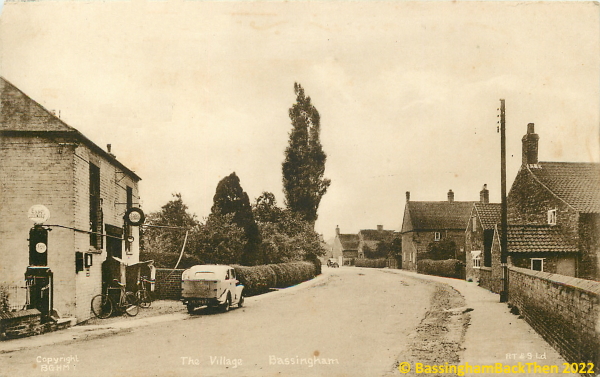
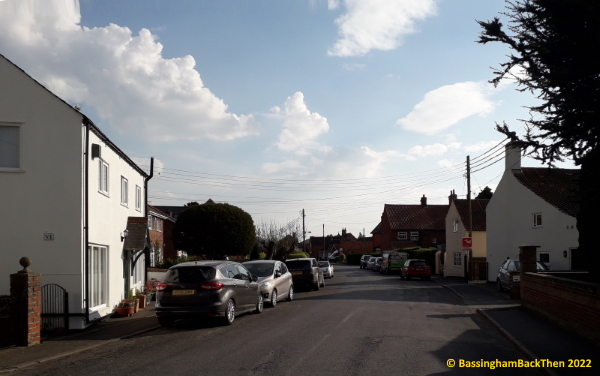 This postcard – catalogue number “BGHM 1” – is one of a series of six showing the village in the early 1940s. It was produced by renowned photographer Raphael Tuck and was first released on 9th August 1942. By this time the Winns had smartened up the frontage of No.1 High Street a little and installed ESSO petrol pumps. Nowadays the frontage has changed quite dramatically as it passed into private hands. There are rather more cars nowadays and the houses on the opposite side of the road, although instantly recognisable, have now been rendered.
This postcard – catalogue number “BGHM 1” – is one of a series of six showing the village in the early 1940s. It was produced by renowned photographer Raphael Tuck and was first released on 9th August 1942. By this time the Winns had smartened up the frontage of No.1 High Street a little and installed ESSO petrol pumps. Nowadays the frontage has changed quite dramatically as it passed into private hands. There are rather more cars nowadays and the houses on the opposite side of the road, although instantly recognisable, have now been rendered.
Christmas card sent to “The Yews”, now 3 High Street

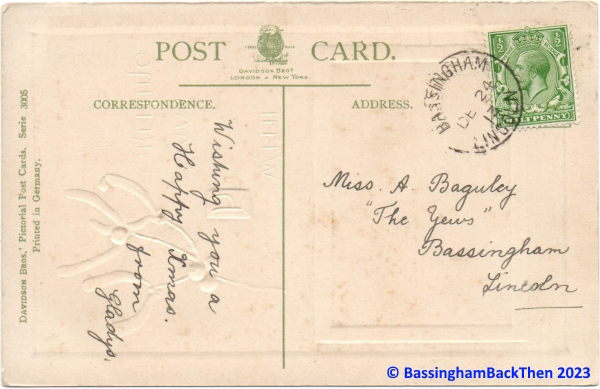
I know that this isn’t really a ‘view’ postcard but I really don’t know where else to put it so I’ll just stick it here! In the 1911 census Amelia Lucy Baguley lived with her parents in Bassingham. You can read more about them HERE.
Northern end of the High Street, looking south (1905)
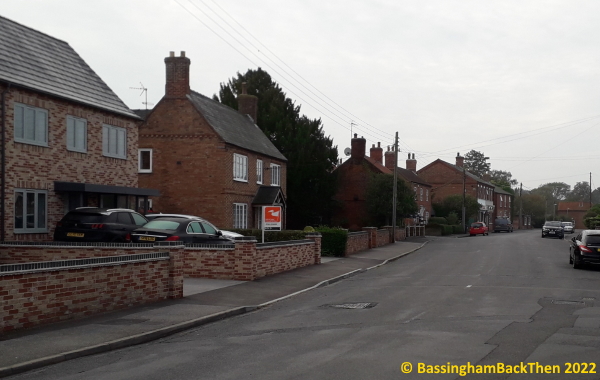 Another view looking south down the High Street. In the distance can be seen the Co-Op and the adjacent shop – as yet without the projecting window – “Honeysuckle Cottage” and the “Five Bells” public house (opened 1746). The number of chimneys and their alignment has changed and the building in the foreground has lost a small top window. One of the two horrendous new buildings can just be glimpsed. In 1697 Church Warden Robert Pondman was the occupant of a house upon the site of the “Five Bells” and he left to the “Towne of Bassingham” £10 for a bell.
Another view looking south down the High Street. In the distance can be seen the Co-Op and the adjacent shop – as yet without the projecting window – “Honeysuckle Cottage” and the “Five Bells” public house (opened 1746). The number of chimneys and their alignment has changed and the building in the foreground has lost a small top window. One of the two horrendous new buildings can just be glimpsed. In 1697 Church Warden Robert Pondman was the occupant of a house upon the site of the “Five Bells” and he left to the “Towne of Bassingham” £10 for a bell. The back of this postally used card (postmarked 12th December, 1905) reads: “Dear M–, I have been waiting some time for a view of this street taken from the other side but as it does not seem to be forth-coming I thought perhaps you would like this one. Sorry I didn’t see C to speak to him on Sunday. I did not know they were over until night. Shall be glad to hear how G is getting on. I was exceedingly sorry when I heard. With love – ever yours sincerely, Alice.” You can also just spot a small ‘x’ over the top of Marshall’s shop in the distance, almost certainly a relative of the recipient. 😉
The back of this postally used card (postmarked 12th December, 1905) reads: “Dear M–, I have been waiting some time for a view of this street taken from the other side but as it does not seem to be forth-coming I thought perhaps you would like this one. Sorry I didn’t see C to speak to him on Sunday. I did not know they were over until night. Shall be glad to hear how G is getting on. I was exceedingly sorry when I heard. With love – ever yours sincerely, Alice.” You can also just spot a small ‘x’ over the top of Marshall’s shop in the distance, almost certainly a relative of the recipient. 😉
Bassingham Co-Op, the High Street (c1910)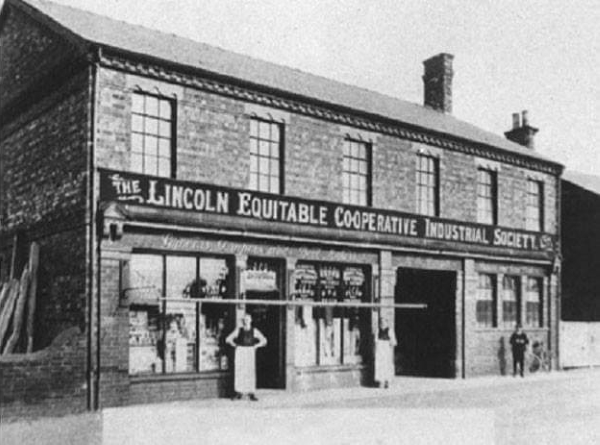
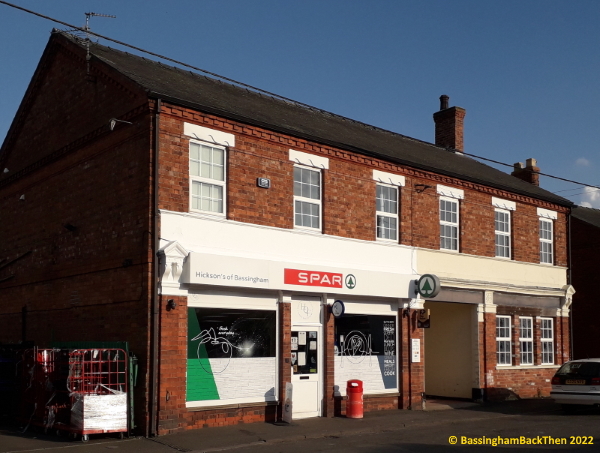 A wonderful photograph showing the Bassingham branch – number 16 – of the Lincoln Equitable Co-Operative Industrial Society, first opened in 1892. That is also undoubtedly the original proprietor, Mr. Arthur Bates, who was still there in the 1930 edition of Kelly’s Directory of Lincolnshire. The building was originally divided at ground level with a pull-in for vehicles in the middle, a shop on one side and a store or bake-house on the other. Nowadays there are subtle architectural changes and the left-end tall chimney is no longer. At the time of the opening of the store, all of the other smaller shops in the village lowered their prices in an effort to combat the Co-Op’s selling power.
A wonderful photograph showing the Bassingham branch – number 16 – of the Lincoln Equitable Co-Operative Industrial Society, first opened in 1892. That is also undoubtedly the original proprietor, Mr. Arthur Bates, who was still there in the 1930 edition of Kelly’s Directory of Lincolnshire. The building was originally divided at ground level with a pull-in for vehicles in the middle, a shop on one side and a store or bake-house on the other. Nowadays there are subtle architectural changes and the left-end tall chimney is no longer. At the time of the opening of the store, all of the other smaller shops in the village lowered their prices in an effort to combat the Co-Op’s selling power.
Each of the following postcards provides a slightly different view of the same subjects, although they do all look very similar.
High Street, looking north (1904)
This postcard can be accurately dated by the postmark of 5th April 1904.

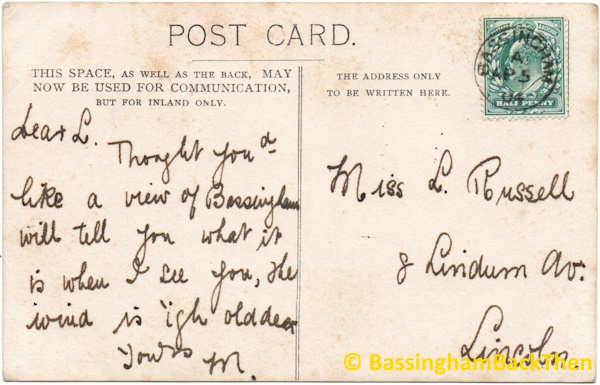
This postcard provides a great contemporary view of two shops (Lincoln Co-Op and Wilson’s) as well as the Five Bells (Inn) which was selling Hall’s Ely Ales back then. There is also evidence of an earlier door now bricked up in the wall nearest to the camera.
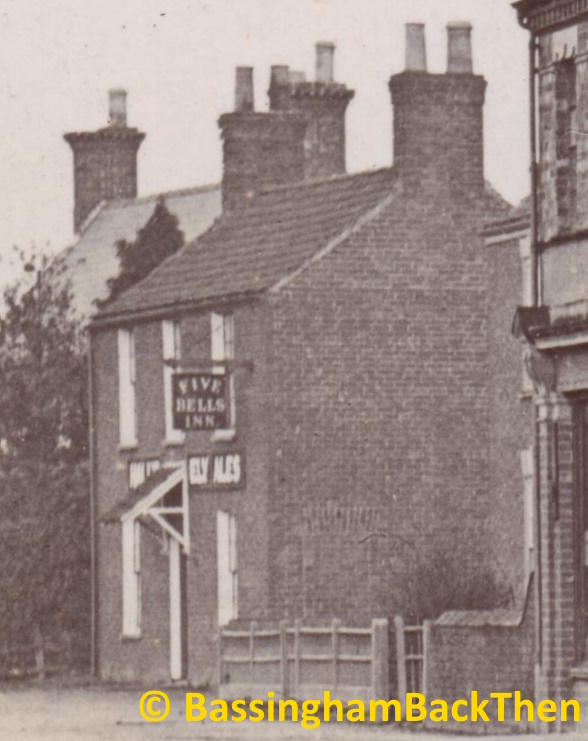
In addition, the postcard shows that the wall nearest the camera was already in a parlous state!
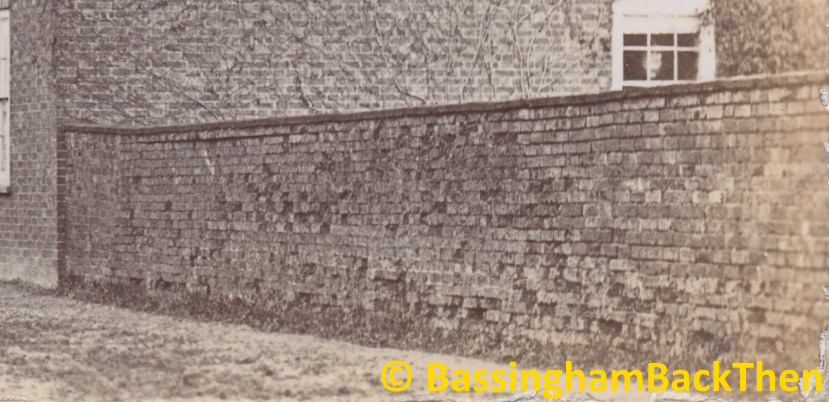
Note also the complete absence of ivy growing on the south wall of what is now “Mayfield House” (25 High Street) compared to a few of the next postcards.
High Street, looking north (1905)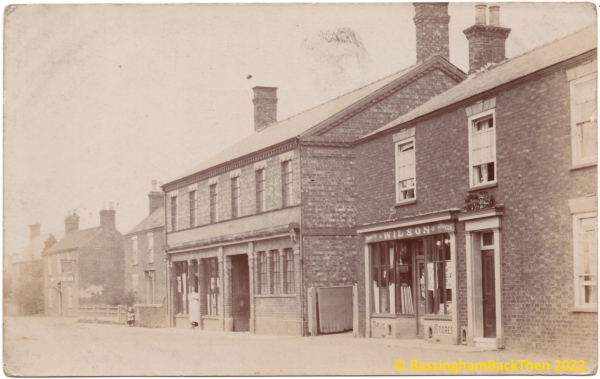
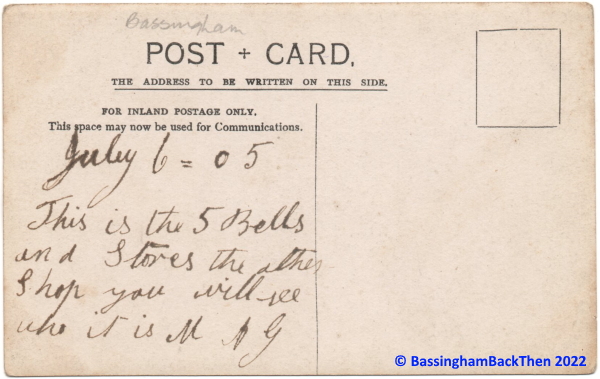 Although this postcard wasn’t actually posted, it is dated on the back “July 6 = 05” which I take to be 6th July 1905. The remainder of the note is somewhat cryptic! “This is the 5 Bells and Stores the other Shop you will see who it is M & G”. Also in view to the right of the pub, with low wooden fencing (and a small girl leaning against the wall!) is “Honeysuckle Cottage”. But of major interest here is the shop next door to the Co-Op which at this point belonged to a Mr Wilson. In the 1900 Kelly’s Directory of Lincolnshire Robert Wilson was listed as a “grocer, linen draper, outfitter, pure drug & oil stores, dealer in horse, cattle & patent medicines”. This close-up gives a great view of his shop front. 🙂
Although this postcard wasn’t actually posted, it is dated on the back “July 6 = 05” which I take to be 6th July 1905. The remainder of the note is somewhat cryptic! “This is the 5 Bells and Stores the other Shop you will see who it is M & G”. Also in view to the right of the pub, with low wooden fencing (and a small girl leaning against the wall!) is “Honeysuckle Cottage”. But of major interest here is the shop next door to the Co-Op which at this point belonged to a Mr Wilson. In the 1900 Kelly’s Directory of Lincolnshire Robert Wilson was listed as a “grocer, linen draper, outfitter, pure drug & oil stores, dealer in horse, cattle & patent medicines”. This close-up gives a great view of his shop front. 🙂 In 1894 the same Robert Wilson had planted young osier willows in a field that he had bought near the River Witham, and he subsequently set up the ‘Osier Factory’ in what is now Battersby Close. This comprised a boiler house and sheds where the stalks were boiled in cauldrons before being more easily stripped of bark and sold to basket-making businesses in the area.
In 1894 the same Robert Wilson had planted young osier willows in a field that he had bought near the River Witham, and he subsequently set up the ‘Osier Factory’ in what is now Battersby Close. This comprised a boiler house and sheds where the stalks were boiled in cauldrons before being more easily stripped of bark and sold to basket-making businesses in the area.
High Street, looking north (1910 and c1916)
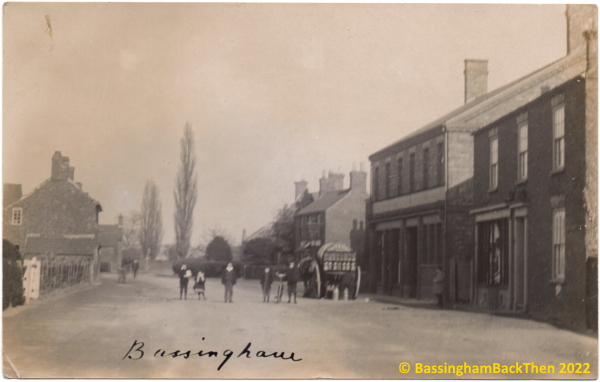

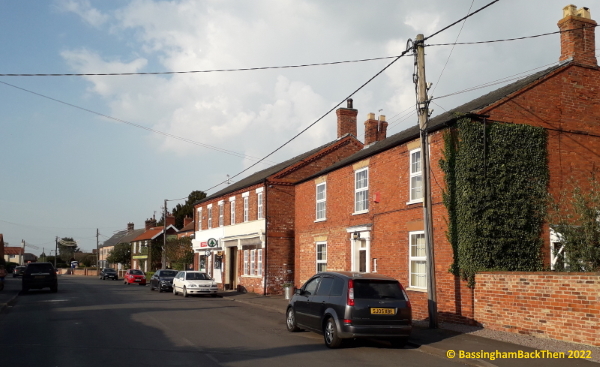 Two very similar views here of the High Street looking north. The first is franked 9th April 1910 (see below) whilst the second is probably a little later (at least judging by the ivy on the gable-end wall of the nearest house). The Co-Op is clearly visible on the right in both, as is the next shop window and the “Five Bells” public house a little further up. The changes are quite obvious: a lick of paint here and there on the old Co-Op has transformed it into the new SPAR shop. Robert Wilson died in 1908; his osier business was taken by a Walter Brown who lived at Haddington, and his shop was taken by grocer William Winn Marshall. The large window of what was once Wilson’s/Marshall’s shop has now gone, replaced by a smaller sash window to match those at the top of what is now a private dwelling (“Mayfield House”, number 25 High Street). The position of the old window is, however, still clearly visible today because of the newer, paler brickwork. The gable-ended building on the left of both old photographs has been demolished and is now home to a bungalow (opposite the “Five Bells“)
Two very similar views here of the High Street looking north. The first is franked 9th April 1910 (see below) whilst the second is probably a little later (at least judging by the ivy on the gable-end wall of the nearest house). The Co-Op is clearly visible on the right in both, as is the next shop window and the “Five Bells” public house a little further up. The changes are quite obvious: a lick of paint here and there on the old Co-Op has transformed it into the new SPAR shop. Robert Wilson died in 1908; his osier business was taken by a Walter Brown who lived at Haddington, and his shop was taken by grocer William Winn Marshall. The large window of what was once Wilson’s/Marshall’s shop has now gone, replaced by a smaller sash window to match those at the top of what is now a private dwelling (“Mayfield House”, number 25 High Street). The position of the old window is, however, still clearly visible today because of the newer, paler brickwork. The gable-ended building on the left of both old photographs has been demolished and is now home to a bungalow (opposite the “Five Bells“)
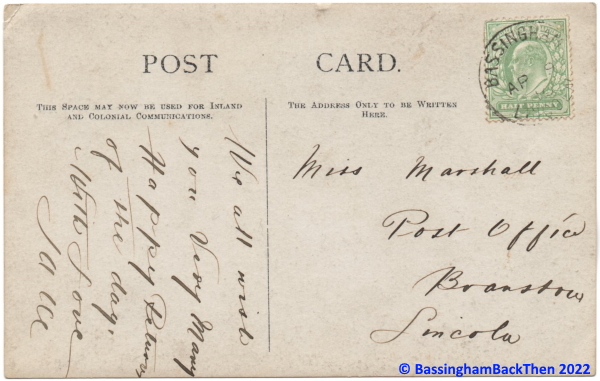
The back of the top, 1910 postcard. Sadly, I cannot decipher the sender’s name, but there is a previous postcard (looking down the High Street) which was sent to the same recipient, a Miss Marshall, Post Office, Branston, Lincoln. Marshall’s seems to have been a rival of the Co-Op. I have also enlarged the detail on the wagon outside the Co-Op… It’s not helped by the fact that the original photograph is blurred, but it appears to be a milk cart for the “White Rose” company. Those are milk churns on the ground, aren’t they? I can’t find any details about such a company, but that’s what it looks like to me. Can you shed any light on this, please?
It’s not helped by the fact that the original photograph is blurred, but it appears to be a milk cart for the “White Rose” company. Those are milk churns on the ground, aren’t they? I can’t find any details about such a company, but that’s what it looks like to me. Can you shed any light on this, please?
High Street, looking North (undated)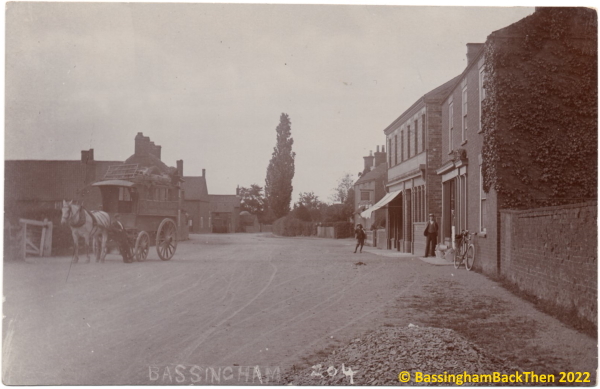 Yet another view of the Co-Op and Marshall’s shop. There are no hints as to a date because the postcard is unused, although the increased ivy on the wall nearest the camera suggests some time after the previous one). Close inspection of the wagon on the opposite side of the street shows that it belonged to ‘Samuel Martin, Carrier Bassingham’ and I have already researched him here and that research shows that he was active in the Carrier business – the 19th century equivalent of today’s “white van man”! 🤣🤣 – between 1871 and c1911. By 1913 he was a farmer and his son, Harry was performing the carriage duties, so my guess would be that this image dates from the early 1900s.
Yet another view of the Co-Op and Marshall’s shop. There are no hints as to a date because the postcard is unused, although the increased ivy on the wall nearest the camera suggests some time after the previous one). Close inspection of the wagon on the opposite side of the street shows that it belonged to ‘Samuel Martin, Carrier Bassingham’ and I have already researched him here and that research shows that he was active in the Carrier business – the 19th century equivalent of today’s “white van man”! 🤣🤣 – between 1871 and c1911. By 1913 he was a farmer and his son, Harry was performing the carriage duties, so my guess would be that this image dates from the early 1900s.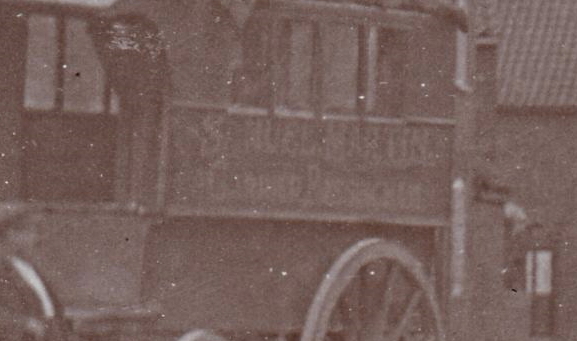
High Street, looking north (undated)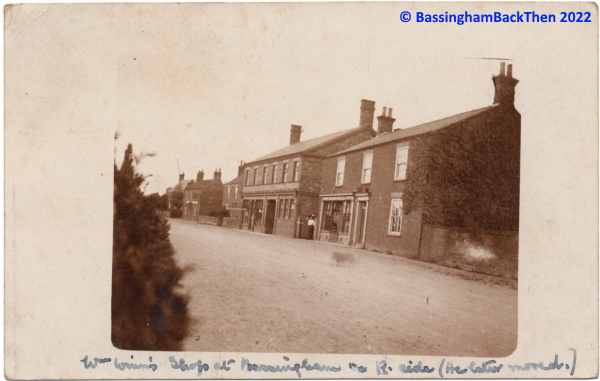 Now this is an interesting one. Although it is undated I would date it as exactly the same time as the previous postcard because the position/spread of the ivy on the gable-ended wall is identical. Because it’s really quite skew-whiff, it looks rather like a private photograph which has been printed up as a postcard (it definitely has the ‘Post Card’ printed template on the back, although it is unused). The inked handwritten note at the bottom reads: “Wm. Winn’s Shop at Bassingham on R. side (He later moved.)” The Lincoln Co-Op is on the left, and the shop on the right is Marshall’s. The Winn reference is because the proprietor was William Winn Marshall who had been a shopkeeper in the village as early as the 1909 Kelly’s Directory of Lincolnshire and was still there in 1930.
Now this is an interesting one. Although it is undated I would date it as exactly the same time as the previous postcard because the position/spread of the ivy on the gable-ended wall is identical. Because it’s really quite skew-whiff, it looks rather like a private photograph which has been printed up as a postcard (it definitely has the ‘Post Card’ printed template on the back, although it is unused). The inked handwritten note at the bottom reads: “Wm. Winn’s Shop at Bassingham on R. side (He later moved.)” The Lincoln Co-Op is on the left, and the shop on the right is Marshall’s. The Winn reference is because the proprietor was William Winn Marshall who had been a shopkeeper in the village as early as the 1909 Kelly’s Directory of Lincolnshire and was still there in 1930.

There were Winns all over the village stretching back to the early 19th century. In the mid-20th century Albert Winn had a bicycle-repairs and garage business opposite Greens Stores on what is now Battersby Close; there was another Winn garage at the north end of the High Street, and the Winn family provided blacksmith services at “Forge Cottage” on Linga Lane dating back to the earliest census of 1841.
High Street, looking north (undated)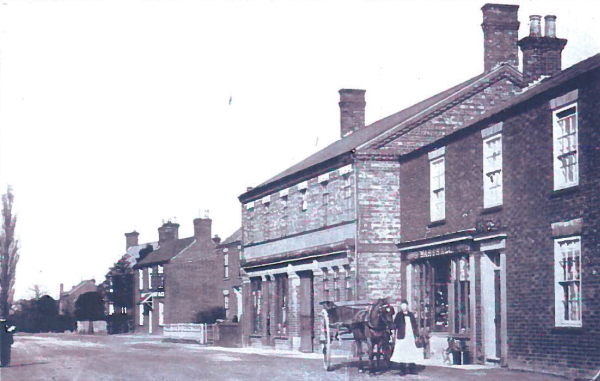 And here is yet another similar view which focuses on the Co-Op, Marshall’s and the “Five Bells” in the background. Of extra interest is the chap with his horse and cart; is that William Winn Marshall himself? (Photo from the Bassingham Community Led Plan of 2015)
And here is yet another similar view which focuses on the Co-Op, Marshall’s and the “Five Bells” in the background. Of extra interest is the chap with his horse and cart; is that William Winn Marshall himself? (Photo from the Bassingham Community Led Plan of 2015)
High Street looking south: The Wesleyan Chapel, Morshead Stores, and “The Tall House”, “Corner Cottage” (c1900-1910)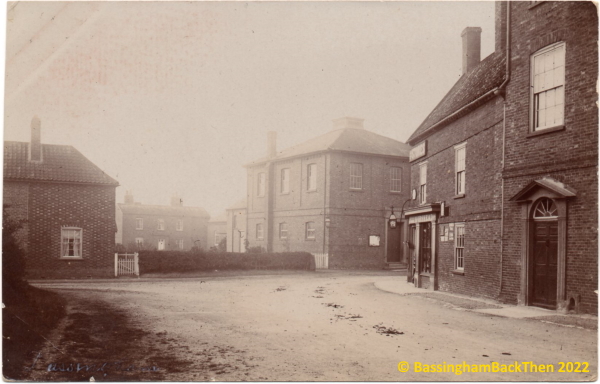
 This postcard is a little different in that it also shows “The Tall House” to the right of the picture (with black door), and is the only postcard that I have found to include this building. Attached to what is now Green’s – but was Morshead’s back then – “The Tall House” is now numbered 24 High Street and is one of the twelve Grade II listed buildings in the village. The house at left is “Corner Cottage”, 2 Eastgate. I would guess that this unused postcard dates to around 1910 or, quite probably, even earlier.
This postcard is a little different in that it also shows “The Tall House” to the right of the picture (with black door), and is the only postcard that I have found to include this building. Attached to what is now Green’s – but was Morshead’s back then – “The Tall House” is now numbered 24 High Street and is one of the twelve Grade II listed buildings in the village. The house at left is “Corner Cottage”, 2 Eastgate. I would guess that this unused postcard dates to around 1910 or, quite probably, even earlier.
The Wesleyan Chapel & Morshead Stores, High Street (c1910 and 1942)

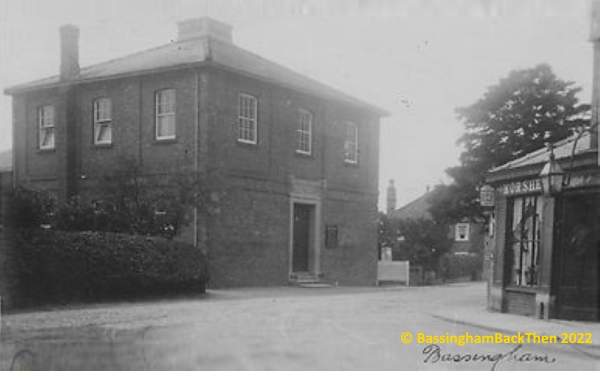
I have issues with the top postcard here – catalogue number “BGHM 2” – as it was supposedly first issued on 9th August 1942, by renowned postcard publisher Raphel Tuck. The problem arises in that John Morshead, whose name appears over the windows, died in 1934 and was succeeded by Robert Green, whose name has adorned the frontage ever since. So why would Tuck hang on to a photograph for eight years before releasing it? Hmmm… Anyway, Green’s Stores is one of the village’s Grade II listed buildings and you can read more about that HERE. For an in-depth detailed history of the business itself click HERE.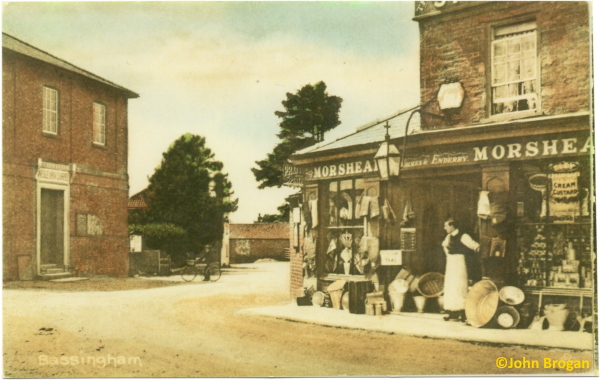 And here’s a ‘tinted’ postcard from around the same time and of the same view, but on this occasion with the proprietor in shot.
And here’s a ‘tinted’ postcard from around the same time and of the same view, but on this occasion with the proprietor in shot.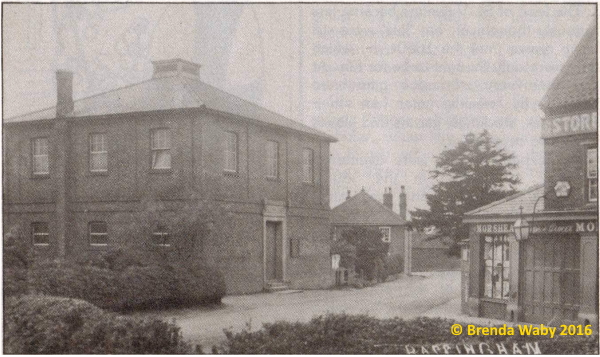 And here’s yet another picture of the same view except this time it was taken from the opposite side of the road, behind the hedge (which is clearly visible in this photograph, the only one to do so). The presence of newsprint in the sky suggests that this photograph was reproduced from the pages of a newspaper. This is also one more of the set of photographs taken by an unidentified publisher as it features the name of the village at the bottom in upper case letters, leaning backward between a pair of ‘guide’ lines. (Photo from the Old Lincolnshire Rural Photos Facebook group).
And here’s yet another picture of the same view except this time it was taken from the opposite side of the road, behind the hedge (which is clearly visible in this photograph, the only one to do so). The presence of newsprint in the sky suggests that this photograph was reproduced from the pages of a newspaper. This is also one more of the set of photographs taken by an unidentified publisher as it features the name of the village at the bottom in upper case letters, leaning backward between a pair of ‘guide’ lines. (Photo from the Old Lincolnshire Rural Photos Facebook group).
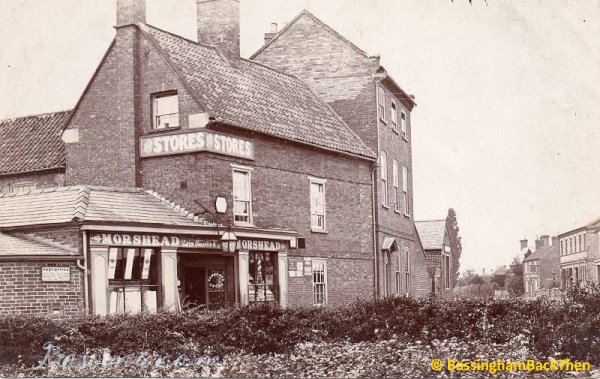
And, finally, a delightfully different view taken from standing on Eastgate and looking north up the street which captures both The Stores and “The Tall House” next door (above). In the distance on the right we can see the “Five Bells” and the Co-Op. The inked “Bassingham” at bottom left – which appears on so many village postcards of this time – identifies it as being the work of local photographer Frederick Kennewell. (Again taken from the Bassingham Memories FB group)
I have a scan of a 1916 Bassingham and District Church Magazine the back of which carries adverts for several local businesses. I love old adverts and their mixed typefaces!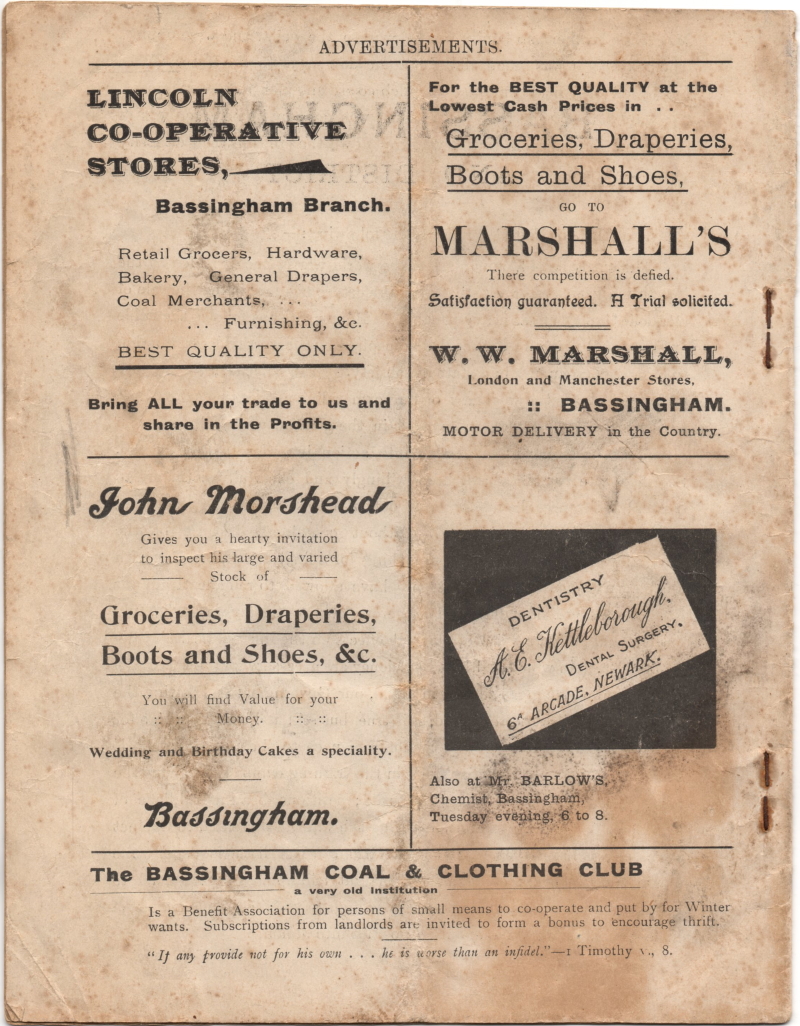
The Wesleyan Chapel, High Street (c1910)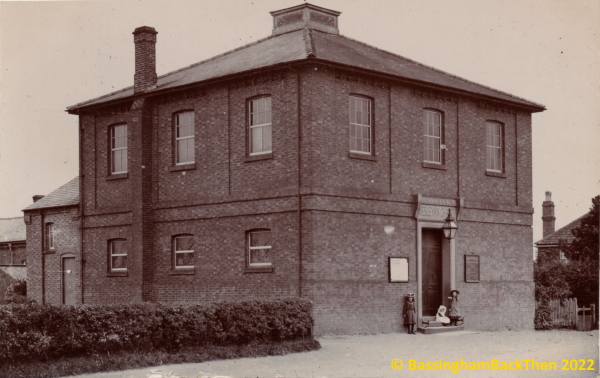
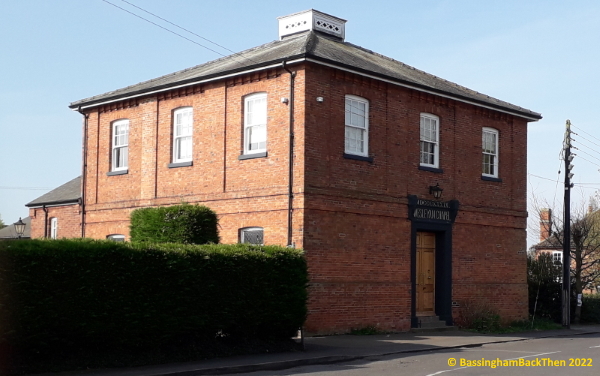 One of the major landmarks in the village is the Wesleyan Chapel which stands on the bend in the High Street. Opened in 1839 and seating 500 people, it replaced an older one on the same site. It is now a Grade 2 listed building, more about which you can read HERE. It has not changed much at all although it is now a private residence. There was also a Wesleyan School Room built at the back of the building in 1855, which became the room where all of the village archives were kept and presided over by the late Helen Ash but is now closed to the public.
One of the major landmarks in the village is the Wesleyan Chapel which stands on the bend in the High Street. Opened in 1839 and seating 500 people, it replaced an older one on the same site. It is now a Grade 2 listed building, more about which you can read HERE. It has not changed much at all although it is now a private residence. There was also a Wesleyan School Room built at the back of the building in 1855, which became the room where all of the village archives were kept and presided over by the late Helen Ash but is now closed to the public.
The Wesleyan Chapel, High Street (c1921)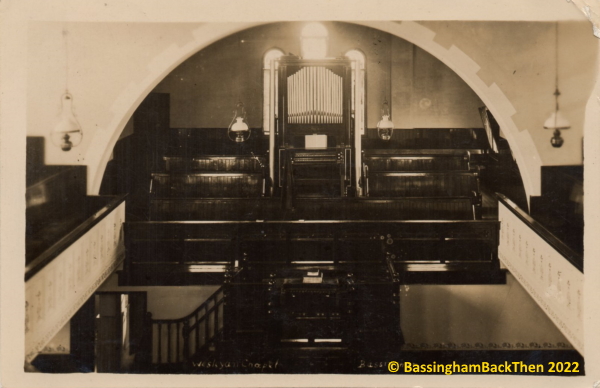
 And here is a rare glimpse inside the Methodist Chapel on a postcard dated 1st July 1921 to Mr. Fred G. Chamberlin, Grand Hotel, Henley, Staffs. for no other reason than to provide a reminiscence of the place! The Chapel has been a private dwelling for some years now but we are fortunate that it came up for sale a few years ago and there was an estate agency photograph which we can use for comparison.
And here is a rare glimpse inside the Methodist Chapel on a postcard dated 1st July 1921 to Mr. Fred G. Chamberlin, Grand Hotel, Henley, Staffs. for no other reason than to provide a reminiscence of the place! The Chapel has been a private dwelling for some years now but we are fortunate that it came up for sale a few years ago and there was an estate agency photograph which we can use for comparison.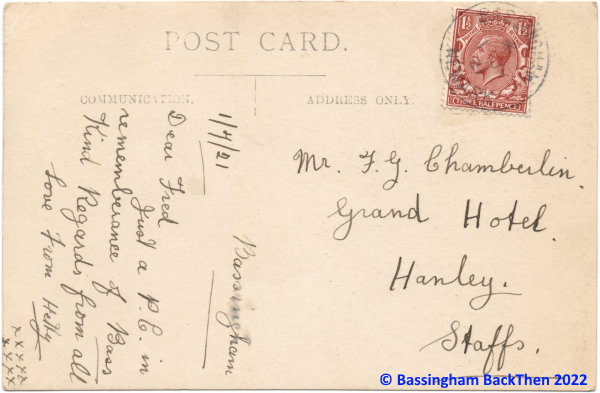 The handwritten message reads, “1/7/21 Bassingham Dear Fred, Just a P.C. [postcard] in rememberance [sic] of Bass. Kind Regards from all Love from Hetty xxxxxxxxx”
The handwritten message reads, “1/7/21 Bassingham Dear Fred, Just a P.C. [postcard] in rememberance [sic] of Bass. Kind Regards from all Love from Hetty xxxxxxxxx”
High Street, southern end, looking south – “Mr Gent’s House” (1905)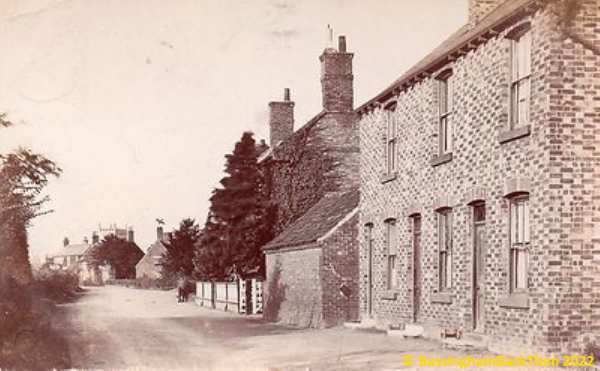
 This is a postcard which was postally used on 28th June 1905. The sender was keen to point out that “Mr Gent’s house” is marked with an ‘X’ above the chimney – it can be seen in the distance, just at the junction with Hall Wath (it’s number 66 High Street). According to the censuses, James Gent was a cordwainer (shoemaker) in the village between 1881 and 1901; his house is now number 62, “Clover Cottage”. The nearest house of the row of three on the right in the immediate foreground is now 48, “Forge House”. The low-roofed building in the centre appears to be unchanged.
This is a postcard which was postally used on 28th June 1905. The sender was keen to point out that “Mr Gent’s house” is marked with an ‘X’ above the chimney – it can be seen in the distance, just at the junction with Hall Wath (it’s number 66 High Street). According to the censuses, James Gent was a cordwainer (shoemaker) in the village between 1881 and 1901; his house is now number 62, “Clover Cottage”. The nearest house of the row of three on the right in the immediate foreground is now 48, “Forge House”. The low-roofed building in the centre appears to be unchanged.
“Sage Cottage”, High Street, southern end (1925)


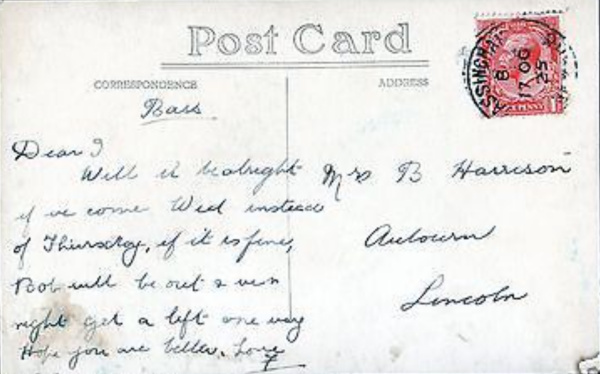
And here is one of the three houses shown previously This postcard was produced much later though and was postally used on 17th October 1925. It almost certainly shows the wife and child occupants standing outside what is now 52 High Street, with the husband undoubtedly taking the photograph. I am unable to provide the names of the family. Save for the rendering, the trellis, a lick of paint, and the ubiquitous SKY dish, very little has changed in the intervening years, although the road level does seem to have been raised in the later 20th century, the large lower step having been swallowed up by the modern tarmac pavement. On the right with the blue door is “Sage Cottage”, 50 High Street.
High Street, southern end, looking south (1916?)
I believe that the possible online date given for this postcard is wrong; if you read on you will see why…

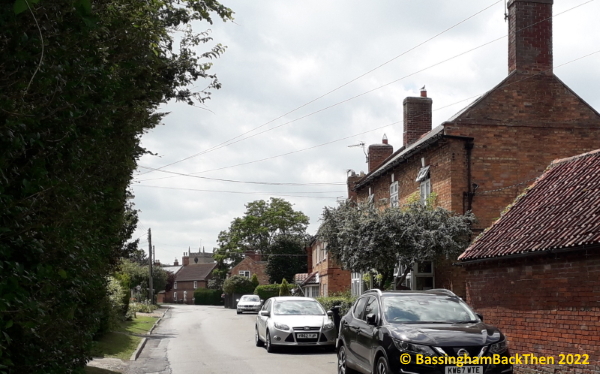 For this postcard we move only a few yards down the road. The small, low-roofed structure on the right which was seen at the centre and then very left edge on the previous postcards, can now be clearly identified on the immediate right of this postcard, as can the white barred gate and fencing. Judging by the presence of a motor vehicle and petrol pump the date is probably somewhere in the 1920s. Indeed, Kelly’s Directory of 1926 is where we find our first mention of an unnamed “Motor omnibus service daily” to Newark and Lincoln.
For this postcard we move only a few yards down the road. The small, low-roofed structure on the right which was seen at the centre and then very left edge on the previous postcards, can now be clearly identified on the immediate right of this postcard, as can the white barred gate and fencing. Judging by the presence of a motor vehicle and petrol pump the date is probably somewhere in the 1920s. Indeed, Kelly’s Directory of 1926 is where we find our first mention of an unnamed “Motor omnibus service daily” to Newark and Lincoln.
In 2023 I managed to get my own copy of the postcard, this time franked in 1932. (Note that my postcard also lacks the “Bassingham” identification pre-printed at bottom right of the postcard above.)

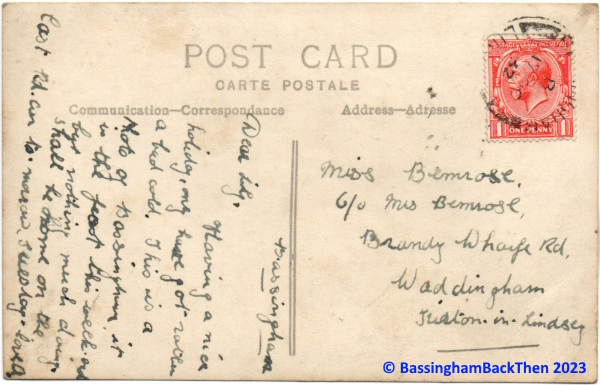
I have produced a large scale scan of the postcard so that the details of the Road Car in it are clearly visible…
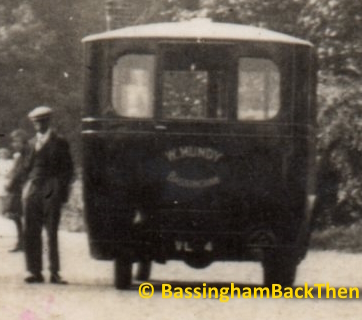
And if you are interested, here’s an enlargement of the petrol pumps and shop front…

The first instance that I can find of a Mundy family in the village is in the 1930 Kelly where William Mundy was an “omnibus proprietor” and he’s there again in the 1933 edition. Born at Wilmslow, Cheshire, on 26th February 1902, William Mundy first appears in the 1911 census living with his parents and siblings in Peterborough. Although he was not in Bassingham by the time of the 1921 census, the aforementioned directories irrefutably place him in the village in the early 1930s (and possibly as early as 1926) and the 1939 Register confirms William Henry Mundy – his middle name revealed – as a “P.S.V. Driver” (Public Service Vehicle) in Bassingham. He would die aged 91 on 13th April 1993, registered at Lincoln.
High Street, southern end looking north (c1910)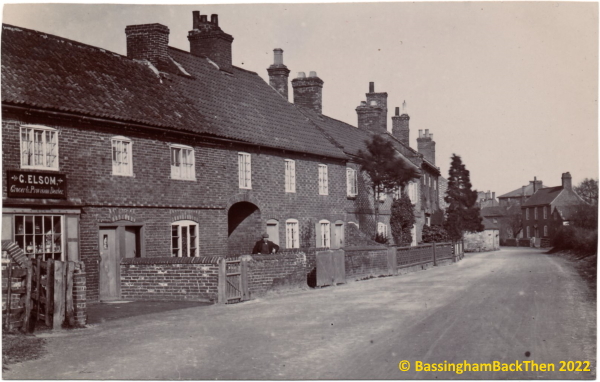
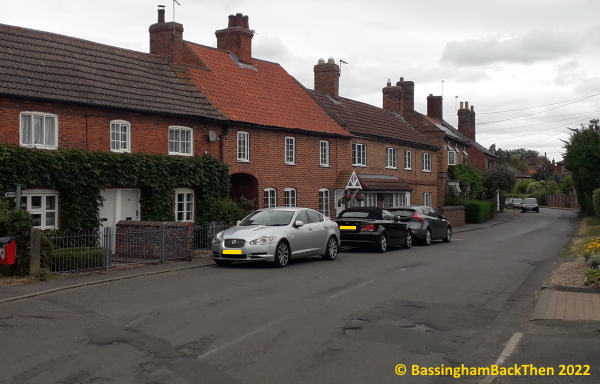 With a view looking back up the High Street from just a bit lower down, this undated postcard offers a lovely view of George Elsom’s shop and the row of small houses to the north of it. And, leaning against the wall of the passage, that is almost certainly the occupant of one of the two houses which are now 60 and 58 High Street. Sadly, the house in the distance on the right in the postcard has since been demolished; it looks lovely! Opposite that house, back over on the left again, one of the village blacksmiths’ forges can be seen, the pale building jutting out into the road.
With a view looking back up the High Street from just a bit lower down, this undated postcard offers a lovely view of George Elsom’s shop and the row of small houses to the north of it. And, leaning against the wall of the passage, that is almost certainly the occupant of one of the two houses which are now 60 and 58 High Street. Sadly, the house in the distance on the right in the postcard has since been demolished; it looks lovely! Opposite that house, back over on the left again, one of the village blacksmiths’ forges can be seen, the pale building jutting out into the road.
G. Elsom: Grocer & Provision Dealer, High Street (c1911)
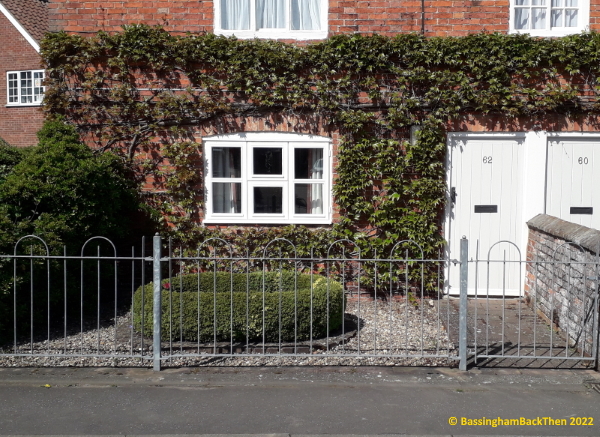 Somewhere between 1905 and 1909 George Henry Elsom from Corby, Liverpool, had set up shop in the village. Referring to the two Directory entries for 1905 and 1909, he doesn’t feature in the earlier one, but he is listed as a “grocer” in 1909. By the time of the 1911 census George seems to have relinquished control of the shop and become a bricklayer, leaving his Sleaford-born wife, Elizabeth, as shopkeeper and mother to their three locally-born small children – Harry (5), Edith (3) and Frank (1). Their home/shop retained George’s name on its frontage and was right at the southern end of the High Street, just up from the junction with Hall Wath. Nowadays the house – number 62 High Street – is very easily recognised although the window has changed, the sign is long gone, the ivy is running wild and the paved frontage has become a small iron-railed garden. (Apologies for the quality of the old picture; it is a photograph of the photograph on the information board on Stocks Green).
Somewhere between 1905 and 1909 George Henry Elsom from Corby, Liverpool, had set up shop in the village. Referring to the two Directory entries for 1905 and 1909, he doesn’t feature in the earlier one, but he is listed as a “grocer” in 1909. By the time of the 1911 census George seems to have relinquished control of the shop and become a bricklayer, leaving his Sleaford-born wife, Elizabeth, as shopkeeper and mother to their three locally-born small children – Harry (5), Edith (3) and Frank (1). Their home/shop retained George’s name on its frontage and was right at the southern end of the High Street, just up from the junction with Hall Wath. Nowadays the house – number 62 High Street – is very easily recognised although the window has changed, the sign is long gone, the ivy is running wild and the paved frontage has become a small iron-railed garden. (Apologies for the quality of the old picture; it is a photograph of the photograph on the information board on Stocks Green).
High Street, southern end looking north (c1920)
 The 1919 Kelly’s Directory of Lincolnshire tells us that Elsom’s shop was now home to a different shopkeeper – Matthew Steel, grocer and provision dealer. Steel also had a carrier service and a motor business which ran to Lincoln and Newark before he sold to William Mundy, the latter starting out with two Chevrolet buses. The frontage looked almost the same, although there was clearly a new sign. The shop would change hands again over the years, ending up a sweet shop run by George and Blanche Bates (circa 1938), with Mrs. Bates finally closing the premises around 1973 upon the introduction of VAT.
The 1919 Kelly’s Directory of Lincolnshire tells us that Elsom’s shop was now home to a different shopkeeper – Matthew Steel, grocer and provision dealer. Steel also had a carrier service and a motor business which ran to Lincoln and Newark before he sold to William Mundy, the latter starting out with two Chevrolet buses. The frontage looked almost the same, although there was clearly a new sign. The shop would change hands again over the years, ending up a sweet shop run by George and Blanche Bates (circa 1938), with Mrs. Bates finally closing the premises around 1973 upon the introduction of VAT.
Going back to the postcard, there were two shops in this little run of buildings; the second was just a few doors up from Steel’s where Charles Marshall had his grocery shop; he can be glimpsed standing outside in his white coat. Lorna Thompson got in touch to say: “Charles Marshall was my father and he lived in Bassingham in “Mayfield House” which was a shop run by his parents. After he married my mother, they ran a shop in what is now “The Old Brewery” and later moved to Navenby and ran a grocery shop.” The home of the Maltster since 1656, “The Old Brewery” is another of the village’s older buildings. In March 1719 Richard Birk’s inventory recorded brewing vessels in the kitchen together with “nine quarter of malt in the chamber”. In 1664 his father had bequeathed to him half the house and the Malt Kiln; Richard in turn handed this on to his son in 1719. In 1765 the property was sold to William Taylor of Burton.
And, finally, further up the High Street, horses can be seen waiting outside the forge of one of the village blacksmiths. The back of the postcard reads: “My Dears, Thought you would like a PC [postcard] of the old place. Thanks ever so much for the nice lunch & thank Eileen for card, sorry we were a day late Eileen. We return home in morning, Kath’s brother is still in bed & only very poorly. Love to you all, Chuck”. I wonder if it was written by Charles Marshall himself? After all, Chuck is a diminutive of Charles, albeit an Americanism…
The back of the postcard reads: “My Dears, Thought you would like a PC [postcard] of the old place. Thanks ever so much for the nice lunch & thank Eileen for card, sorry we were a day late Eileen. We return home in morning, Kath’s brother is still in bed & only very poorly. Love to you all, Chuck”. I wonder if it was written by Charles Marshall himself? After all, Chuck is a diminutive of Charles, albeit an Americanism…
High Street, southern end looking north (c1910 and 1912)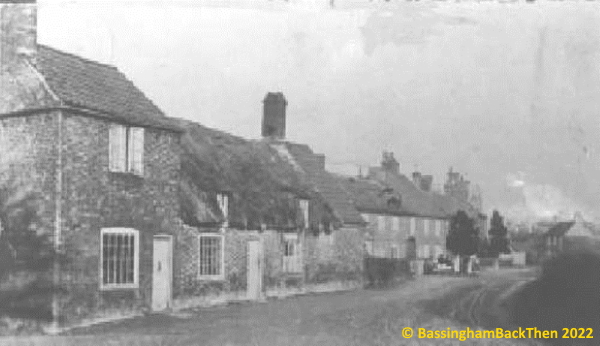
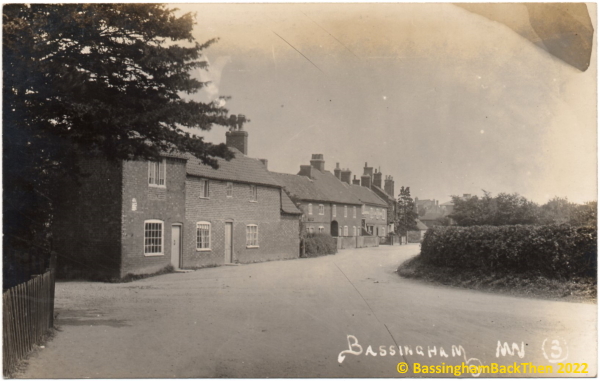
 Two postcards here, both easily identifiable as the bottom end of the High Street just before it becomes Newark Road. The top picture was taken c1910 and clearly pre-dates the one below which was postally used postcard in October 1912. The thatch of the second cottage has gone to be replaced by more brickwork, raised windows and ridged terracotta roofing tiles. With the thatch removed, the owner also clearly took the opportunity to add a small window in the upper floor between the two existing windows on either side of the cottage. The modern view of this end of the High Street shows just how little it has changed. The hedging at right in the older postcards has now grown into a fully-fledged tree-line and what was open ground behind it now houses a large bungalow with a spacious garden. The corner cottage is now number 66 High Street, but back in the time of the postcards it was the home of James Gent (see earlier reference).
Two postcards here, both easily identifiable as the bottom end of the High Street just before it becomes Newark Road. The top picture was taken c1910 and clearly pre-dates the one below which was postally used postcard in October 1912. The thatch of the second cottage has gone to be replaced by more brickwork, raised windows and ridged terracotta roofing tiles. With the thatch removed, the owner also clearly took the opportunity to add a small window in the upper floor between the two existing windows on either side of the cottage. The modern view of this end of the High Street shows just how little it has changed. The hedging at right in the older postcards has now grown into a fully-fledged tree-line and what was open ground behind it now houses a large bungalow with a spacious garden. The corner cottage is now number 66 High Street, but back in the time of the postcards it was the home of James Gent (see earlier reference).
The War Memorial (1942)
 Here is another of the six Raphael Tuck postcards which were released on 9th August 1942. This one is catalogued “BGHM 4”; have we missed one? What happened to “BGHM 3”? Anyway, the monument is situated at the junction of the southern end of the High Street, Newark Road and Lincoln Road. To read more about its history click HERE.
Here is another of the six Raphael Tuck postcards which were released on 9th August 1942. This one is catalogued “BGHM 4”; have we missed one? What happened to “BGHM 3”? Anyway, the monument is situated at the junction of the southern end of the High Street, Newark Road and Lincoln Road. To read more about its history click HERE.
Nowadays there is a great amount of foliage and shrubbery which obscures the buildings that line the southern end of the High Street. Immediately behind the War Memorial there is now a large bungalow with an enormous – and very well maintained – garden.
Ralph Perkins’ blacksmith’s shop occupied this site and rumour has it that it was from here that the “Great Fire of Bassingham” spread in 1664.

 BACK HOME
BACK HOME
Used to go to school at the back of the chapel in the late 50’s and used to go in Mrs Bates shop and of course Greens when it was owned by Greens great memories you have shown me on your posts thankyou.
LikeLike
I’m really pleased that you like the site, John, and that they have brought back good memories for you.
Keep watching! 😉
Roger
LikeLike
Winns garage that you show before Maurice Walton had it as an electrical shop Henry Rusin had it still a garage (Henry was a Polish fighter pilot in ww2 ) he moved accross the road to larger premises eventually becoming Metheringham car sales when Henry retired. The “Yews” next door is where Mrs Beasent used to live.
LikeLike
Thanks again, John.
I knew about Mrs Bessant and “The Yews” but the details about the garage are new and I will update the info on the page.
Roger 👍
LikeLike
No.1 High Street was built in 1860 , after it was a hairdresser’s it was purchased in 1995 and was a wedding gown salon and is still with the same owner as a private home.
LikeLike
Many thanks for this information.
I shall amend the narrative accordingly.
Roger 👍
LikeLike